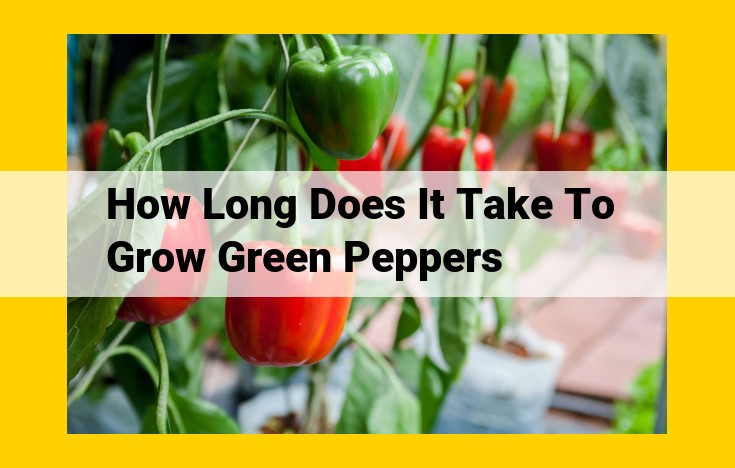Growers should note that the duration to cultivate green peppers varies depending on the variety. On average, plants take approximately 60-90 days to mature from transplanting, offering a harvest of crisp and succulent green peppers. Environmental factors such as temperature and sunlight play a crucial role in the growth rate, influencing the time required for maturity.
Essential Factors for Pepper Cultivation
- Climate (temperature, sunlight, humidity)
- Soil (pH, fertility, drainage)
- Water and nutrients
Essential Factors for Pepper Cultivation: A Foundation for Success
Peppers, with their vibrant hues and irresistible flavors, are a beloved culinary staple worldwide. To cultivate these delectable plants successfully, it’s crucial to understand the essential factors that influence their growth and well-being.
1. Climate: A Symphony of Temperature, Sunlight, and Humidity
Peppers thrive in warm, sunny environments. Optimal temperatures range from 20 to 29 degrees Celsius. They require abundant sunlight, at least six hours per day, to produce abundant fruits. Humidity plays a vital role in disease prevention and should be maintained between 50 and 60%.
2. Soil: The Foundation of Plant Health
Peppers prefer well-drained, fertile soil with a pH between 6.0 and 6.8. The soil should be rich in organic matter, which provides essential nutrients and improves drainage. Adequate soil fertility ensures a continuous supply of nutrients for growth and fruit production.
3. Water and Nutrients: The Lifeblood of Pepper Cultivation
Regular watering is essential for pepper growth, especially during hot and dry weather. Avoid overwatering, as it can lead to root rot. Fertilizer applications provide the necessary nutrients for optimal plant development. Choose a balanced fertilizer and apply it according to the manufacturer’s instructions. Nitrogen is crucial for leaf growth, while phosphorus and potassium support fruit development.
By understanding and meeting these essential factors, you can create a nurturing environment for pepper cultivation, setting the stage for a bountiful harvest of these culinary gems.
Common Pests and Diseases in Pepper Cultivation
Prevention and control of pepper pests and diseases are crucial for a successful harvest. Let’s dive into the common foes and explore strategies to keep your plants thriving.
Pests: Tiny Troublemakers
-
Aphids: These tiny insects suck sap from leaves, causing yellowing and wilting.
-
Spider mites: They spin fine webs on the underside of leaves, sucking out cell contents and weakening plants.
-
Thrips: These minute creatures feed on plant tissue, leaving silvery streaks and causing leaf distortion.
Diseases: Foes to Fend Off
-
Blossom-end rot: Caused by calcium deficiency, this disease manifests as dark, sunken spots on fruit.
-
Bacterial leaf spot: This bacterial infection causes circular, water-soaked spots on leaves, leading to premature defoliation.
Prevention and Control: A Proactive Approach
Prevention is key. Ensure proper plant spacing to promote air circulation and reduce humidity, which attracts pests. Choose disease-resistant varieties and rotate crops to avoid disease buildup.
Regular plant inspections are essential. If pests are detected, organic insecticides like neem oil or pyrethrin can be used. Biological control, such as introducing predatory insects like ladybugs or lacewings, is also an effective option.
For diseases, practicing good sanitation by removing infected plant material and using clean tools helps prevent spread. Copper-based fungicides can be applied as a protective measure. However, remember to follow label instructions carefully.
By understanding these common pests and diseases and implementing preventive measures, you can safeguard your pepper plants and enjoy a bountiful harvest.
The Culinary Delights of Bell Peppers: A Culinary Journey
When it comes to versatile and flavorful ingredients, bell peppers reign supreme in the culinary realm. These vibrant and luscious fruits (yes, they’re botanically classified as fruits!) offer a symphony of colors, flavors, and culinary possibilities.
Varieties and Versatility
The world of bell peppers is a colorful tapestry of hues, from the iconic green and red to the captivating orange, yellow, and even chocolate varieties. Each color boasts a unique flavor profile, ranging from a crisp and mild green to a sweet and juicy red. Whether you crave a fiery kick or a delicate crunch, there’s a bell pepper to suit every taste.
Harvesting Excellence
Patience is key when it comes to harvesting the finest bell peppers. As they mature, they gradually transition from a deep green to their vibrant final shades. Size and firmness are also crucial indicators of ripeness. A ripe bell pepper should feel slightly heavy for its size and have a firm, glossy skin.
Storage Secrets
To preserve the freshness and flavor of bell peppers, proper storage techniques are essential. Keep them unwashed in a cool, dark place, ideally between 40-45°F (4-7°C) and 85-90% humidity. Under these optimal conditions, bell peppers can retain their quality for up to 2-3 weeks.
Culinary Canvas
In the kitchen, bell peppers are a culinary canvas that invites creativity and experimentation. Their versatility shines through in a wide range of dishes, from classic stir-fries to vibrant salads. Their crisp texture and sweet flavor make them a delectable addition to fajitas, pizzas, and hearty stews. Roasted bell peppers take on a smoky, caramelized sweetness that adds depth to any dish.
Whether you slice them thin for salads, grill them for a smoky flavor, or stuff them with savory fillings, bell peppers bring a burst of color, flavor, and nutrients to every culinary creation. Their high vitamin C content makes them a healthy addition to any diet, and their antioxidant properties contribute to overall well-being.
From vibrant salads to tantalizing stir-fries, bell peppers are a culinary delight that offers endless inspiration. So next time you’re craving a touch of color and flavor, grab a fresh bell pepper and embark on a culinary adventure that will tantalize your taste buds.
